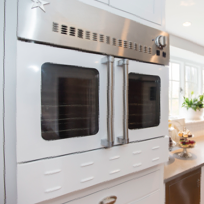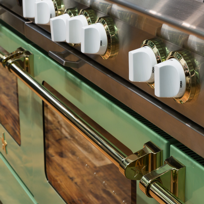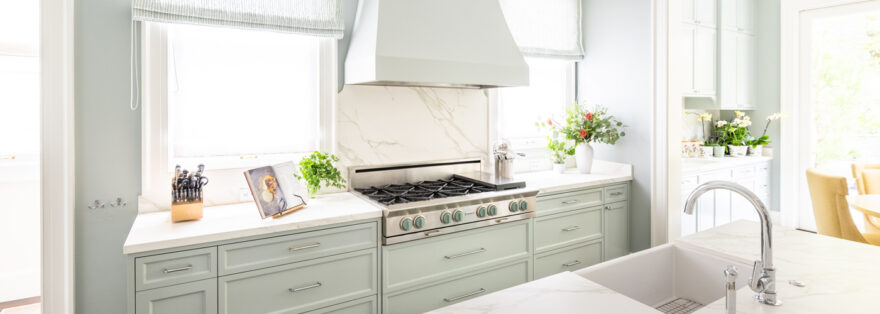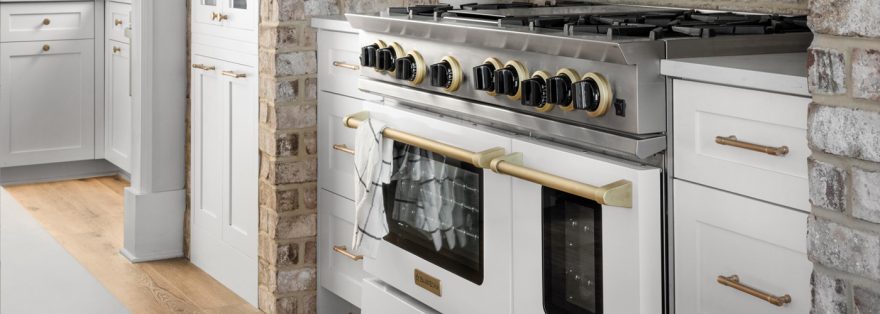When restaurateur Ed Schoenfeld recites his address to dinner guests, he gets blank stares.
“They assume Queens,” he says of his home, located in the Forest Hill neighborhood of Newark, NJ. “And then when I say Newark, I get a raised eyebrow.”
That raised eyebrow quickly turns into a dropped jaw when guests enter Schoenfeld’s 21-room Georgian house, which dates back to 1909.
Schoenfeld, 67, owner of West Village Chinese fusion restaurants RedFarm and Decoy, and his wife, Elisa Herr, made the decision to leave Ditmas Park, Brooklyn, five years ago. They realized their commutes to downtown Manhattan would be faster and easier — less than 30 minutes — with a Garden State ZIP code.
They chose Forest Hill, a sheltered enclave of stately homes that is a 15-minute drive from downtown Newark.
Historic details, such as numbered window plates and a 1903 Baldwin piano, sold them on the house, which came with furniture and cost less than $1 million.
But of course, a century-old home comes with baggage.
“A few years after we moved in, we walked downstairs and found a corner of the ceiling on the floor,” says Schoenfeld. “We realized it was a prime opportunity to make the home feel more like ours.”
Enter Sasha Bikoff, the 29-year-old owner of her eponymous design firm, who was tasked with overhauling the mansion. Priorities for the couple, who admired Bikoff’s work and commitment to repurposing items, included updating the home’s color palette and figuring out placement for their heirlooms, antiques and one-of-a-kind finds.
To begin, Bikoff painted the formerly aubergine entryway a bold African violet.
Combined with the jade green of Schoenfeld’s office on the right, the sunny yellow of the dining room on the left and the dusty pink of the living room at the rear of the house, the aesthetic is meant to evoke a flower bouquet.
The living room is an ideal example of how Bikoff reinvented what the couple already owned. “The joke was that Sasha would go shopping in our attic,” says Schoenfeld. Bikoff overdyed a rug that belonged to Herr’s mother to match the pink walls, then fixated on a chinoiserie storage cabinet — another family piece from Herr.
“Ed hated it, so we had just shoved it in an upstairs corner,” says Herr. But it became the ideal TV stand.
One key purchase? Turquoise window treatments. “That’s where we spent the painful money,” says Schoenfeld. “And they don’t do anything!”
To anchor the dining room, Bikoff raided the house for more treasures.
On the mantel, two ginger jars flank a tiger sculpture. A large rough-hewn table was purchased from folk art dealers in the neighborhood. Bright blue curtains complement Schoenfeld’s extensive collection of Royal China’s “willow ware” dishes.
In the summer, the couple entertains in the solarium.
A black-and-white checkered pattern was painted on the original floorboards; the table was part of a former restaurant project and retrieved from storage. Visitors often end the evening in the hot tub, steps away from the screen door.
Outside, the gardens contain two fish ponds. A walkway winds over the water and into a corner gazebo. A weeping birch, magnolias and dogwoods are the ideal backdrop for the Japanese-themed picnic Schoenfeld is planning for 200 guests later this spring.
The second floor houses a den, the master bedroom and — separated by sliding pocket doors — an office suite where Herr, co-editor of Moody’s Credit Outlook reports, works from home. In the evenings, the couple listens to music from a Sonos sound system in the cozy dark blue den. The black-and-white master bedroom provides an oasis of calm — and a favorite nesting spot for the couple’s 14-year-old tabby mix, Cocoa Chai Latte.
But the focal point of the second floor is the landing’s ceiling, where a starry gold skyscape glitters against a deep blue background. (It came with the place.)
“We imagine it was the result of some ’60s acid trip,” says Schoenfeld. He liked the ceiling decoration so much that he took photos prior to construction and had workers reproduce the image star by star in gold leaf.
The house’s top level was designed with guests — including the couples’ three grandchildren — in mind.
Its rooms, painted in shades of lime green, pink, and turquoise and furnished with overdyed heirloom rugs, are a nod to Schoenfeld’s bohemian background.
“This is me when I graduated prep school,” explains Schoenfeld, pointing to a portrait of a clean-cut young man. “And this is me a year later.” Schoenfeld picks up a framed photo of a man who could be confused for a long-lost cousin of Jerry Garcia. “I gave up a full scholarship to NYU to work in a Chinese restaurant. My parents wanted to kill me.”
But his parents relented when they saw Schoenfeld find success reinventing Chinese-American cuisine, beginning with the 1973 opening of Uncle Tai’s on the Upper East Side. Even though Schoenfeld studied under legendary Chinese cooking instructor Grace Chu, he considers himself a self-taught cook.
“I cook almost every day,” says Schoenfeld, whose freezer is filled with homemade stocks. And despite making the rounds at Decoy and RedFarm every evening, Schoenfeld and Herr make it a priority to have dinner together at home most nights.
The centerpiece of the tin-ceilinged kitchen is a mint-green BlueStar range with built-in wok burners. A rustic sign reading “APPLES” — a Maine flea market find— sits above.
Adorning the buttery yellow walls are shelves for Schoenfeld to display many of what Bikoff affectionately terms his “curiosities.”
Schoenfeld says one of the best parts of his home’s redesign was finding Bikoff herself: She is designing his new restaurant, The Mess, a bistro slated to open later this spring on East 13th Street.
Back in the kitchen, multiple walk-in pantries allow ample storage space for both dry goods and china — Schoenfeld estimates he has enough dinnerware to serve close to 300 guests — although Herr says that number is more like 100.
“Well, in any case, it’s a lot,” Schoenfeld acquiesces. The pantry is currently filled with imported Di Gragnano pasta. In preparation for an upcoming trip to Italy, Schoenfeld is experimenting with Chinese takes on Italian classics.
As spring rolls on, the house is filled with flowers purchased biweekly from the Newark flower district. Schoenfeld also frequents the Montclair greenmarket, the Popular Fish Market in the Ironbound district, and Seabra’s, a Portuguese food emporium where he regularly stocks up on olive oils.
And although he loves exploring Forest Hill’s grand prewar homes, Schoenfeld’s favorite place is home. “When I walk around the house, I go, ‘Nice! I like this, I like that,’ ” he says.
“It’s a good feeling.”
















